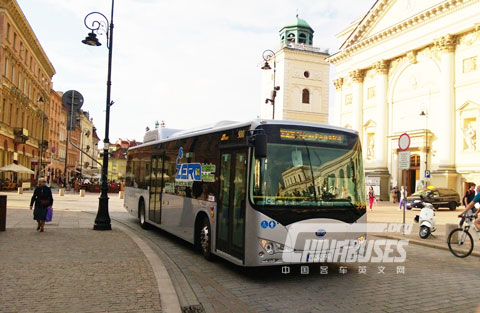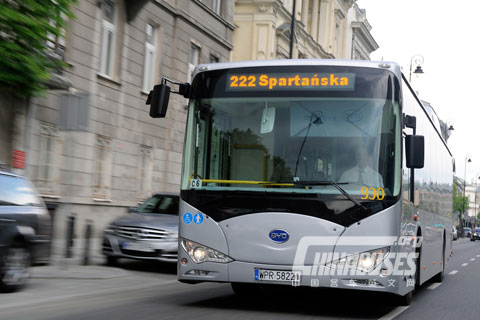Comfort of journey and fuel savings
The BYD ebus delivers a host of benefits not only for the environment but also for the public transport and the bus operator. It does not emit any harmful fumes into the environment. What is more, it is very quiet and ensures a comfortable journey without the vibrations, jerks or noise associated with the conventional buses with combustion engines.
Operators appreciate the fuel savings. The price of electricity per 100 km for the BYD ebus equals to 50 zloty, while the current combustion engines consume more than 40 l. of diesel fuel per 100 km, which costs at least 200 z?/ 100km. With a daily mileage of 250 km, the bus provides saving of at least 395 zloty per day, and 10,665 zloty for 27 working days (one month). For that reason one bus may provide savings of at least 127,980 zloty annually.
Zero emission
The BYD ebus is an all-electric vehicle. It does not emit harmful fumes into environment. This pure electric solution guarantees an appropriate range of the bus no matter what the road conditions.
The BYD ebus is a unique vehicle, from the start it was built as an electric bus and not a converted bus from a conventional power unit. What is more, it features appropriate weight distribution, thanks to the smart utilization of the battery weight, and that is why it has great level of driveability.
The ebus also has a well-developed system of energy recovery, which allows the batteries to be recharged during braking.
250 km on one charge
The BYD ebus can drive for 250 km even in heavy city traffic after one full charge. This is the furthest range of any electric bus. Charging time depends on the applied charger. The bus that is tested charges in the depot in just 5 hours from a completed depleted battery.
Pure electric BYD buses have been used in public transport since 2011. In China already 1,000 such buses have been built In the city of Shenzhen, 200 BYD electric buses have together accumulated almost 17 million km in passenger carrying service. In the first quarter of 2013 the BYD ebus obtained full European certification. This allowed the company to start selling buses on the European market. The Dutch province of Friesland is the first place in Europe where BYD electric buses are in use.
BYD ebus
The ebus built by BYD, is the first pure-electric bus powered by Iron-Phosphate battery in the world.
More than 250 BYD ebuses are now in passenger carrying operations - by far the largest number from any bus brand. BYD ebus measures 12 meters long and is designed for customer transport comfort in mind. The technically advanced and specially designed wheel-hub motor, and its electronically controlled air suspension can offer customers a product with an exceptionally low floor, multiple door choices, and ample floor space for easy passenger access.
The imposing windscreen occupies two thirds of the frontal area of the bus for maximum viewing as well as safety. The bus body conveys an elegant exterior image, while the interior boasts an air of quality with adjustable driver’s seat, durable seats for passengers and a carefully engineered sound insulation keeping the interior ride whisper quiet.
BYD’s pure electric bus employs many advanced technologies developed in-house by BYD’s 15,000 engineers strong R&D team. For example, the Iron-Phosphate battery or “Fe Battery” used on the BYD ebus is safe and non-polluting: the materials contained in the battery can be recycled or safely disposed of.
BYD ebus Project
Orders have been awarded in China, the Netherlands, Finland, Denmark, Uruguay, Canada and the United States. The BYD electric bus has also been successfully tested in many cities in Europe including Madrid, Barcelona, Budapest, Salzburg, and etc. The accumulated mileage of the 200 electric buses operating in the city of Shenzhen(China) alone have exceeded 16.7 million kilometers (or 10.4 million miles) by the end of May 2013.
BYD ebus Highlights
Environmentally friendly
• No direct emissions
• Low noise
• Recyclable Fe battery: no toxic electrolytes and no heavy metals
Advanced technology
• Regenerative Braking
• Wheel-hub motor
• Fe battery
• Charging convenience
• Fully charged in 5 hours.
Extended range
• The BYD ebus is able to run 250 km (155 miles ) on a single charge in urban conditions
Safety
• Unibody construction
• 4-wheel disc brakes
• ABS and ASR
Passenger-oriented design
• Airy designed interior space with low-entry
• Special ramps for wheelchair access
• Non-step passenger cabin
Wheel-hub Motor
The in-house developed rear drive axle installed on the BYD ebus is the core technology in BYD’s electric buses. The rear drive axle system integrates the wheel-hub drive and regenerative braking technologies, and at the same time, provides exceptional passenger comfort.
Compared to the conventional motor, the rear drive axle system has no gear box, no transmission shaft, and eliminating differential mechanism, therefore BYD is able to cut down the bus weight by 300kg and also greatly saving space. Thanks to the revolutionary design, power from the motor is directly transmitted to the driving wheels, there are significant improvements in power propulsion efficiency and reductions in noise and vibration.
Charging Facilities
The on-board AC charging technology developed by BYD is unique to the electric bus, requiring only 5 hours to fully recharge the BYD ebus.
Since the AC charging system has a direct connection to the grid, it can charge not only the batteries but correspondingly, in an emergency, transmit power back onto the grid from the batteries, for example, in a black out situation.
On-board AC charging system advantages:
1. Independent of charging stations.
2. Charging box is much smaller and lighter, and more convenient to transport than a conventional charging cabinet.
3. Low maintenance costs.
4. Suitable for various locations; easy to operate.
5. Charging is both safe and pollution free, therefore charging box can be installed in the building without concerns for hydrogen gas emission..
6. Operators are encouraged to take advantage of the off-peak hours in the evening to charge the vehicles reducing demand pressure on the grid.
7. Electricity can be transmitted back onto the grid from the on-board batteries, when necessary, for emergency power supply.
8. AC charging system is more cost-effective than DC charging system.

